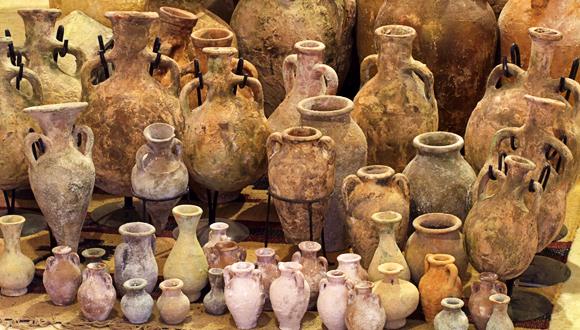
The size and shape of spherical vessels reflected a non-metric measurement system used in Ancient Egypt.

A team of archeologists and mathematicians from Tel Aviv University has discovered a unique, ancient system of calculating volume that differs significantly from the metric system we use today. The method appears to have been used by Egyptians and Phoenicians from the 14th to the 10th century BCE. It allowed merchants (and their clients) to accurate estimate the amount of oil, wine and other products stored in spherical containers and was entirely based on the sphere rather than the cube as a way to measure length and volume.
The Hekat and the Royal Cubit
Until this discovery archeologists believed merchants in antiquity had no accurate, standardized way of measuring the volume of fluids transported in ceramic vessels. However, digital analysis of hundreds of pots and jars found at Tel Megiddo and other sites across the Middle East revealed a strong correlation between the size and volume of these containers. The discovery was made by Professor Itzhak Benenson, head of the Department of Geography and the Human Environment at Tel Aviv University, researcher Elena Zapassky and Professor Israel Finkelstein and Dr. Yuval Gadot from the Department of Archeology.
Ancient Egyptians used a measuring unit called the "royal cubit", equivalent to approximately 52 centimeters, to measure length, and a "hekat", equivalent of approximately 5 liters, to measure volume. When TAU researchers began to measure ceramic vessels in cubits and hekats rather than meters and liters they came across an astounding discovery. Vessels with a circumference of one royal cubit could hold approximately half a hekat's worth of liquid. The correlation, repeated across hundreds of containers, is very unlikely to be accidental and indicates Ancient Egyptians had a method of accurately measuring liquid in a spherical container.
Standardization in the Ancient World
This Egyptian measuring system was adopted by Phoenicians and was still used in the area long after the fall of Egypt's New Kingdom in the late 12th century BCE. Researchers believe this is yet another indication of Egypt's immense political and cultural influence over the region, as it wasn't until the Assyrian conquest – in the 8th century BCE – that new measuring systems were introduced. Interestingly, as the royal cubit and the hekat were slowly phased out, the shapes and sizes of vessels used for transport and trade changed in accordance with new, Assyrian, measurement systems.
No comments:
Post a Comment